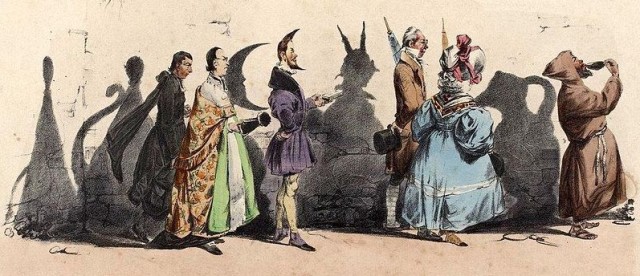.jpg/640px-Ales%2C_Mikulas_-_Karlstejnsky_havran_(1882).jpg) |
| Painting by Mikoláš Aleš. |
* I started to write "survival horror game" but realized that would be terribly misleading. Everyone in The Sound of Black Wings dies.
.jpg/640px-Ales%2C_Mikulas_-_Karlstejnsky_havran_(1882).jpg) |
| Painting by Mikoláš Aleš. |
The Grand Intergalactic Five and Dime celebrates the connection between objects and memory. The game takes place in a large ramshackle spaceship that wanders between the stars, trading as it moves from one settlement to the next. The shopkeeper occasionally accepts cash, but has found it easier to let visitors barter for the items they find on the crowded shelves filling the ship's two main galleries.
Players should sit in a comfortable circle. The first player becomes a customer and the player to her left takes on the role of the shopkeeper. The two should spend a moment bantering back and forth before bartering. They can share small talk, the captain could compliment the multi-hued sheen of the customer's tentacles--anything that fits the mood of the group. Eventually the pair moves to the business at hand. The players each introduce what the characters would like to trade, offering wondrous descriptions of alien artifacts. They can ask one another questions, or add details ("The gem's deep blue reminds me of the Seas of Romlig!"). The values of the items can vary dramatically. A collection of pebbles could be traded for a crown that enhances the owner's telepathic powers, for example.
The items traded during the ship's journey reflect the rich and sometimes surreal variety of cultures and civilizations in the universe. During play, however, participants will base the goods they wish to trade on items that have deep sentimental or nostalgic value for the players themselves. A player, for example, still has a rainbow yo-yo he won at a school carnival held at a long-closed grade school. Assuming the role of shopkeeper, he could offer a customer the Medallion of Lartnec, the two multicolored discs worn by the High Oracle of Mahtal as she performs the ceremony that guarantees that gravity will continue to work properly for the next millennium.
The pair's turn ends with the customer and the captain of the merchant ship excitedly and graciously agreeing to the trade. Play then shifts to the left, with the person who played the captain becoming the new customer and the player to her left stepping into the merchant's shoes.
The game has no set endpoint. You can agree to a number of rounds before starting, or play as a warmup for other story games.
Cinquain is the strange child of chess and gomoku. Beginning with an empty chess board, players work to create a line of five pieces either by placement or movement.
Each player begins with a standard chess set of sixteen pieces. On her turn, a player can choose to place a piece on the board or move one already in play. Pieces can be placed on any open square (the two black bishops, for example, can be on squares of the same color and pawns can be placed on any rank). There is no limit on the number of open-ended lines of three or four a player may have.
Kings, queens, bishops, knights and rooks can be moved, following the general rules of movement in chess. Pawns neither move nor promote, although they still count as part of a line of five. There are two changes to a king's movement, however. There is no capturing in cinquain, so kings can be placed and moved without worrying being in check. Also, there is no castling.
The first player to create a line of exactly five pieces wins.
 |
| Stefano Brivio |
 Pine Grove has seen joy, tragedy, and mystery over the course of its long history. It’s a small town with a long past where you’ll find that everyone and everything is connected in some way if you just ask the right questions.
Pine Grove has seen joy, tragedy, and mystery over the course of its long history. It’s a small town with a long past where you’ll find that everyone and everything is connected in some way if you just ask the right questions.
The Centauri Tree is a story game for two or three players in which
they narrate the history of an alien world from the perspective of a
lone tree. The players describe the ecology and culture of the world,
crafting short interwoven poems as the game unfolds.
You will need a maple seed to play. Mark one side of the seed with a
pen or marker. As a player begins a new turn she tosses the seed into
the air. If it lands with the unmarked side up, her poem will be about
the ecology or natural history of the world, focusing on themes like the growth of the tree, the animals who shelter in its branches, and weather and climate. If the marked side is
showing, the poem will explore the history of the planet’s sentient inhabitants who live near the tree, which grows through the seasons as communities evolve, individuals look at the world with hope and wonder, and the families respond to crisis and change. These poems can include contact with other worlds. You can use dice or cards in lieu of a seed.
On her turn, the player will write a haiku-like poem reflecting the
theme of the seed toss. The poem should have three lines, with the
first and third having at most five syllables and the second line having
at most seven.
The next player tosses the seed and begins a new poem. The first
line of her poem, however, must be the same as the third line of the
previous poem. This pattern continues as the players alternate turns,
resulting in six interconnected poems.
After the group has created six poems, each player takes a moment to
write a seventh that connects the opening and closing of the cycle. The
final poems should use the third line from the sixth poem as the
opening, and the first line from the first poem as the final line.